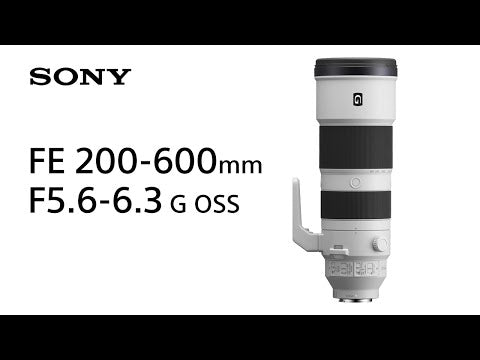Product Description
Sony FE 200-600mm f5.6-6.3 G OSS Telephoto Lens
- E-Mount Lens/Full-Frame Format
- Aperture Range: f/5.6 to f/36
- Five ED Elements, One Aspherical Element
- Nano AR Coating and Fluorine Coating
- Direct Drive Super Sonic Wave AF Motor
- Optical SteadyShot Image Stabilization
- Dust and Moisture-Resistant Construction
- Removable, Rotating Tripod Collar
- Rounded 11-Blade Diaphragm
Long-Reaching, Stabilized Zoom
Designed for full-frame E-mount cameras, this super-telephoto can also be used on APS-C models to achieve an equivalent 300-900mm focal length range.
The maximum aperture range of f/5.6-6.3 helps minimize size and weight while providing excellent performance in a variety of applications.
Optical SteadyShot image stabilization helps to minimize the appearance of camera shake for sharper imagery when shooting handheld with slower shutter speeds.
OSS has three dedicated modes, including panning and viewfinder stabilization priority settings, and can also be combined with a select camera's sensor-shift type image stabilization for more effective control of camera blur.
Internal zoom design limits the overall length of the lens while zooming for more intuitive and comfortable handling.
Compatible with optional 1.4x and 2x FE teleconverters for further increasing the lens's reach.
Five extra-low dispersion elements are featured in the lens design and help to control chromatic aberrations and reduce colour fringing for increased clarity and colour fidelity.
One aspherical element is placed at the rear of the optical design and reduces distortion and spherical aberrations in order to produce a high degree of sharpness and accurate rendering.
A Nano AR Coating has been applied to minimize surface reflections, flare, and ghosting for increased contrast and colour rendering in strong lighting conditions.
A rounded 11-blade diaphragm contributes to a pleasing bokeh quality when employing selective focus techniques.
Fast and Precise Autofocus
Direct Drive Super Sonic wave Motor (DDSSM) AF system provides quick, quiet, and precise autofocus performance that suits both stills and video applications.
Linear Response manual focus control offers more natural handling and an AF/MF switch is located on the lens barrel for tactile control over this setting.
Three customizable focus hold buttons are present on the lens barrel for intuitive tactile control and rapid access to select settings.
A minimum focusing distance of 7.9', along with a maximum magnification of 0.2x, benefits portraiture and head shots.
Focus range limiter and focus hold controls offer more intuitive handling and faster performance when photographing moving subjects.
Professional, Durable Design
Dust and weather-sealed construction benefits using the lens in inclement shooting conditions.
The front lens element features a fluorine coating to protect against smudges and dust from adhering to the glass surface.
Removable rotating tripod mount permits quick switching from horizontal to vertical shooting orientations.
For full specifications click Here




























